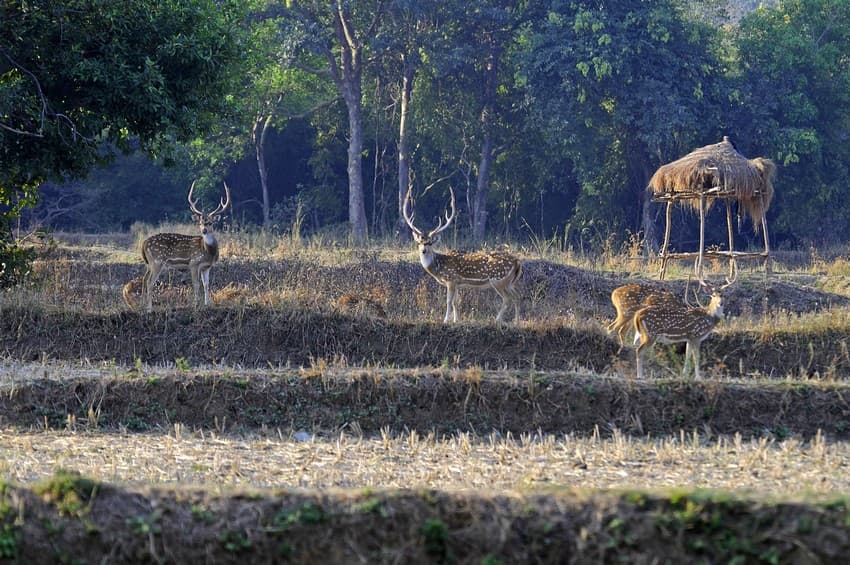The wounds reappear every winter,” said Sabulal Kasdekar, and pulled up his pants to his thighs. His legs, discoloured by burn scars, were painful to look at. The story behind the scars was equally painful. Kasdekar lived in the Mangia village in the core zone of the Melghat Tiger Reserve. At the peak of winter, when temperatures dropped to 40C, and his wheat crop was ready to be harvested, he spent the nights awake, guarding his crop from chital and wild pigs, by a bonfire. The fire kept him warm, but also burnt his legs. For villagers whose agricultural lands abut forests, crop raiding by wild herbivores is an agony they have to live with. Guarding the crop manually has its own risks; in Kasdekar’s case, it resulted in burns over his legs. Other methods to deter wild herbivores, like trenches and different kinds of fences, come with their own cost and risk, and none of the methods are foolproof.

Agricultural fields on the fringes of forests are frequently raided by wild herbivores. Photo: Anish Andheria
An Underreported Problem
Human-carnivore conflict attracts attention and creates headlines, but it is crop depredation by wild herbivores that impacts poor farmers in a more widespread, frequent and damaging manner. While the former happens sporadically and creates chaos, the latter occurs at a larger scale and is regular and constant. “As there is no bloodshed when crops are raided by wild herbivores and the damages are not quantifiable on a daily basis, the problem is not perceived as a serious one, and is underreported. The cumulative effect of losses on poor farmers and the village economy is more significant than assumed,” says Dr. Anish Andheria, President of the Wildlife Conservation Trust.
While compensations are promptly doled out when a tiger injures or kills cattle, there is much ambiguity regarding compensation for losses caused by herbivores. This happens because it’s difficult to ascertain whether the damage is caused by wild herbivores, cattle, or humans. Authenticating claims is a major challenge for a short-staffed Forest Department. In addition, the amounts given are not as significant as in the case of carnivore conflict. All these factors discourage farmers from lodging complaints and claiming compensation from the Forest Department.
Resentment Leads To Retaliation
The build-up of resentment, anger and frustration leads to two negative outcomes. One, it develops in the minds of villagers an outlook of indignation towards the Forest Department; and second, it develops a mindset of retaliation for the unfair treatment, which can take the form of poisoning and electrocution of wild animals, laying snares and traps, and collecting excess wood and other forest produce.
Among all of these, electrocution has the worst impact on wildlife populations. Overhead wires are illegally tapped to fence agricultural fields, and also laid out in the open with the intention to kill wild animals. Only if a tiger or a leopard is killed by such wires, is when news about the incident spreads. If a herbivore is electrocuted, it is slaughtered and the meat distributed among families of the village, leaving no trace of the animal’s existence. On a yearly basis, the number of small and big wild animals electrocuted in Central India may run in the thousands.


Justicia adhatoda, commonly known as adulsa (left), and Aloe vera (right) are among the 20 species of high-value medicinal plants that are unpalatable to wild herbivores, and can be successfully grown around Protected Areas in Central India. Photo: Poorva Joshi.
Ending A Vicious Cycle
The retaliatory killing of wild herbivores kicks off a vicious cycle. As herbivores are killed by electrocution, wild prey populations tumble. This, in turn, increases attacks by wild carnivores on livestock, escalating conflict, and driving more retaliation.
In an attempt to find solutions to end this vicious cycle that drives the killing of wildlife and threatens the livelihood of subsistence farmers, Poorva Joshi, a botanist and biodiversity and conflict management consultant, has been working on medicinal-plant-based alternative livelihoods around Protected Areas in Central India. Her focus is on medicinal plants that are not only unpalatable to wild herbivores, but also fetch good market value. Over the last four years, working in villages along the western boundary of the Tadoba-Andhari Tiger Reserve (TATR), she has identified medicinal plant species based on growth, minimum care, commercial value and unpalatability to herbivores, and conducted trial plantations to test how well they grow in the soil and climatic conditions around the tiger reserve.

Pune-based botanist Poorva Joshi promotes medicinal-plant-based alternative livelihoods
as a means to mitigate human-herbivore conflict. Photo: Poorva Joshi.
During 2018-19, with support from the Wildlife Conservation Trust’s Small Grants (WCT-SG), she developed pictorial manuals for the propagation of 20 species of unpalatable medicinal crop plants that have good economic value, and can be incorporated into current agricultural systems around Protected Areas in Central India. The manuals cover all aspects of the species’ life cycle, and the conditions and efforts required to propagate them – flowering and fruiting seasons; suitable weather and soil conditions; high-yield varieties; organic fertilisers needed; cultivation methods; nursery preparation methods; plantation processes; manure and compost application suggestions; irrigation methods; species-specific pests and diseases, and organic solutions to those; harvesting methods and cycles; postharvest management; value addition processes; medicinal uses and budgets.
As part of her efforts to develop a working model for the successful and sustainable cultivation of these alternative crops, Joshi conducts awareness programmes and trains farmers in adopting these crops. Next on the anvil is the development of a nursery of these plants in the buffer zone of TATR, and the formation of farmer’s associations to synergise their efforts in successfully cultivating and profitably marketing their harvests.
Communities living on the fringes of forests depend on agriculture for their subsistence, and are on the frontline of climate change, facing its adverse effects in the form of erratic and untimely rains, hailstorms and other extreme weather conditions. If the efforts in promoting wild-herbivore-unpalatable medicinal plants are successful, one can hope for a better future for both wildlife and communities.
First published in Sanctuary Asia, February 2020
——————————————————————————————————————————————————————
About the Author: Rizwan Mithawala is a Conservation Writer with the Wildlife Conservation Trust and a Fellow of the International League of Conservation Writers.
——————————————————————————————————————————————————————
Disclaimer: The author is associated with Wildlife Conservation Trust. The views and opinions expressed in the article are his own and do not necessarily reflect the views and opinions of Wildlife Conservation Trust.
Related Links
- Human Wildlife Interface Management
- Small Grants
- Dharti Rakshaks Of Melghat
- Illegal Wildlife Trade: The Need to Look Within
- WCT and Google Research India have come together in an exciting collaboration
